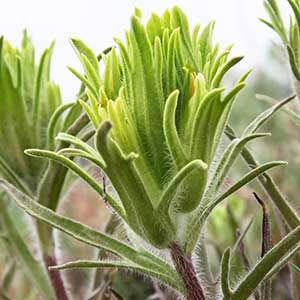Castilleja oresbia
Castilleja flava
pale paintbrush, pale Wallowa Indian paintbrush, pale Wallowa paintbrush
rustic paintbrush, yellow Indian paintbrush, yellow paintbrush
few to several, erect or ascending, sometimes decumbent at base, unbranched or branched, hairs usually retrorse, medium length, ± soft, eglandular, mixed with very short-glandular ones, sometimes with spreading, long, soft ones.
several to many, erect or ascending, often grayish, unbranched or often branched distally, glabrate proximally or hairy, especially distally, rarely glabrous, hairs sparse, spreading to appressed, usually curly, ± short, soft, sometimes mixed with sparse, short stipitate-glandular ones.
green to purple, linear to lanceolate, 2–7 cm, not fleshy, margins plane, involute, 3–5(–7)-lobed, apex acuminate to acute;
lobes spreading, linear to sometimes narrowly lanceolate, apex acute.
often grayish or purplish, linear to narrowly lanceolate or narrowly oblong, (1–)2.5–5(–6.7) cm, not fleshy, margins plane or wavy, involute, deeply (0–)3–5(–7)-lobed, apex acute to acuminate;
lobes divaricate to spreading or ascending, linear, arising at or below mid length, apex acute to acuminate.
2.5–18 × 1–3.5 cm;
bracts pale green to yellow-green or pale, dull reddish brown throughout, or proximally so colored but changing gradually to cream or yellowish on distal margins, narrowly to broadly lanceolate, (3–)5–7(–9)-lobed;
lobes ascending, linear, long, proximal lobes arising below mid length, central lobe apex obtuse, others acute.
3.5–20(–29) × 1–4 cm;
bracts pale green to pale yellow throughout, or proximally pale green to pale yellow, distally pale yellow to bright yellow, sometimes light orange, light red, or bright red, lanceolate to narrowly oblong or narrowly elliptic, slightly broader than leaves, usually 3–5-lobed;
lobes ± spreading, linear or narrowly lanceolate, short or long, proximal or all bracts arising near or below mid length, apex acute, sometimes narrowly obtuse.
straight, 21–36 mm;
tube 16–20 mm;
teeth of abaxial lip often exserted, beak exserted;
beak adaxially green, 4.2–5.5 mm;
abaxial lip green to purple, distally white, conspicuous, slightly but noticeably pouched, often visible through front cleft, 3–5 mm, 67–100% as long as beak, puberulent;
teeth erect, white, 1.8–2.1 mm.
straight or ± curved, 13–30 mm;
tube 12–16 mm;
beak, sometimes abaxial lip, slightly to strongly exserted, corolla often curved and exserted through abaxial cleft;
beak adaxially green, (5–)6–12 mm;
abaxial lip green or yellow, reduced, exserted or more commonly visible in cleft in calyx, 1–3.5 mm, 20–33(–50)% as long as beak;
teeth ascending, green to yellow, 0.5–2 mm.
colored as bracts, 10–25 mm;
abaxial and adaxial clefts 6–7 mm, 30–60% of calyx length, deeper than laterals, lateral 5–10 mm, 40–50% of calyx length;
lobes linear, apex acute.
proximally green, sometimes purple or pinkish, distally yellow to light orange, dull green, or colored as bracts, 11–28 mm;
abaxial and adaxial clefts 4–16(–17) mm, 30–60(–95)% of calyx length, deeper than laterals, lateral 0.5–7 mm, 4–30% of calyx length;
lobes linear to lanceolate or narrowly to broadly triangular, apex acute to acuminate.
= 48.
Castilleja oresbia
Castilleja flava
Castilleja oresbia is endemic to eastern Oregon and adjacent Idaho. It is easily confused with both varieties of C. pallescens, which also occur in sagebrush habitats. Castilleja oresbia has longer calyx lobes and softer pubescence than C. pallescens var. pallescens, although some transitional specimens are found. Castilleja oresbia has a combination of longer calyx lobes, longer pubescence, and obscurely nerved bracts, which usually serve to separate it from C. pallescens var. inverta. All three have different, though somewhat overlapping, ranges. Castilleja oresbia occasionally hybridizes with C. peckiana in Grant County, Oregon.
(Discussion copyrighted by Flora of North America; reprinted with permission.)
Varieties 2 (2 in the flora).
Both varieties of Castilleja flava are characteristic plants of sagebrush-dominated communities throughout its wide range, from valleys to moderate elevations in the mountains, sometimes reaching the lower subalpine. The species almost always occurs in close association with shrubby species of Artemisia.
(Discussion copyrighted by Flora of North America; reprinted with permission.)
1. Corolla beaks 5–12 mm, abaxial lips 1–2 mm; calyx abaxial clefts 8–16 mm, adaxial 4–8(–15.5) mm; n Great Basin, c Rocky Mountains. | var. flava |
1. Corolla beaks 5–8(–9.5) mm, abaxial lips (1.5–)2–3.5 mm; calyx abaxial and adaxial clefts subequal, (6–)7–13(–17) mm; mountains of ne Oregon to c Idaho. | var. rustica |


